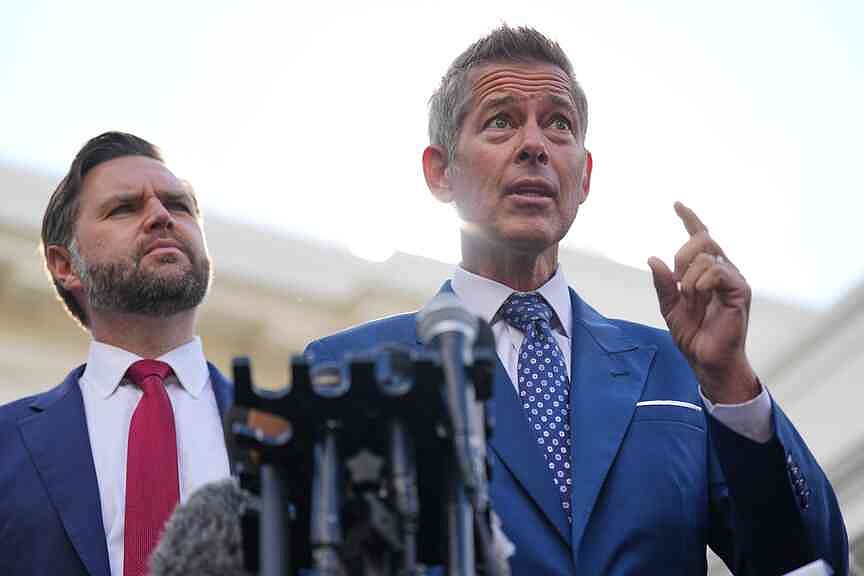Copyright Arkansas Online

WASHINGTON -- The Federal Aviation Administration said Wednesday it would reduce air traffic by 10% across 40 "high-volume" markets beginning early Friday to maintain safety during the ongoing government shutdown. The reduction stands to affect thousands of flights nationwide because the FAA directs more than 44,000 flights daily, including commercial passenger flights, cargo planes and private aircraft. Also Wednesday, President Donald Trump lashed out at Senate Republicans to end the government shutdown, now the longest ever at 36 days, blaming the impasse for the party's defeat in closely-watched elections while Democrats, emboldened by their off-year victories, dug in for a fight. Air traffic controllers have been working unpaid since the shutdown began Oct. 1. With some calling out of work, staffing shortages during some shifts have led to flight delays at a number of U.S. airports. Citing growing staffing pressures, FAA Administrator Bryan Bedford said the agency would not wait for a crisis to act. "We can't ignore it," he said. Bedford and Transportation Secretary Sean Duffy said they would meet with airline executives Wednesday to determine how to safely implement the reduction in flights. Until then, both declined to name the affected markets. Bedford said a list would be released sometime Thursday. "If the pressures continue to build even after we take these measures," Bedford said, "we'll come back and take additional measures." The FAA sometimes slows down or stops flights from taking off toward an airport because of weather conditions or when there aren't enough controllers and other personnel or facilities are unable to pick up the slack. Last weekend saw some of the worst staffing shortages of the shutdown. From Friday to Sunday evening, at least 39 different air traffic control facilities announced there was some potential for limited staffing, according to an Associated Press analysis of operations plans sent through the Air Traffic Control System Command Center system. The figure, which is likely an undercount, is well above the average for weekends before the shutdown. During weekend periods from Jan. 1 to Sept. 30, the average number of airport towers, regional centers that oversee multiple airports and facilities that monitor traffic at higher altitudes announced the potential for staffing issues was 8.3, according to the AP analysis. But during the five weekend periods since the shutdown began on Oct. 1, the average more than tripled to 26.2 facilities. Most controllers have continued to work mandatory overtime six days a week during the shutdown. That leaves little time for a side job to help cover bills, mortgage payments and other expenses unless controllers call out. CONGRESSIONAL RUMBLES Trump, whose first term at the White House set the previous government shutdown record, said this one was a "big factor, negative" in Tuesday's races. He revived his demands for Republicans to end the Senate filibuster as a way to reopen government -- something senators have refused to do. At the same time, Democrats hardened their resolve after sweeping governor's races in Virginia and New Jersey and the mayor's race in New York. The Democratic leaders said Trump needs to get serious about negotiating an end to the stalemate and resolve the problem of expiring health care subsidies that are central to the debate. "The election results ought to send a much needed bolt of lightning to Donald Trump that he should meet with us to end this crisis," said Senate Democratic Leader Charles Schumer of New York. Expectations were high that the logjam would break once results were tallied in elections that were widely watched as a gauge of voter sentiment over Trump's second term. But Trump's demands on Wednesday that Republican senators get rid of the filibuster as a way to end the shutdown complicated an already difficult situation. And Democrats facing divisions within their progressive and moderate ranks said the results showed that voters will reward them for the fight. "It's time for Republicans to do what they have to do, and that's terminate the filibuster," Trump said during a breakfast meeting Wednesday with GOP senators at the White House. Trump told the GOP senators they could bring the shutdown to a close by ending the Senate rule, which requires a 60-vote threshold for advancing most legislation, and steamroll the Democratic minority. Republicans now hold a 53-47 majority in the Senate, and Democrats have been able to block legislation that would fund the government, having voted more than a dozen times against. That push from Trump is likely to go unheeded by Republican senators -- Senate Majority Leader John Thune said later changing the filibuster does not have support and is "not happening" -- but it could spur them to deal with the Democrats. 'SAD LANDMARK' Trump's approach to the shutdown stands in marked contrast to his first term, when the government was partially closed for 35 days over his demands for money to build the U.S.-Mexico border wall. At that time, he met publicly and negotiated with congressional leaders. Unable to secure the money, he relented in 2019. This time, Trump stayed out of the shutdown debate, instead keeping a robust schedule of global travel and events, including at his private Mar-a-Lago club in Florida. And it's not just Trump declining to engage in talks. The congressional leaders are at a standoff, and House Speaker Mike Johnson, R-La., sent lawmakers home in September after they approved their own funding bill, refusing further negotiations. A "sad landmark," Johnson said at a news conference Wednesday about the record shutdown. The speaker dismissed his party's election losses and said Democrats need to drop their demands on health care until after the government reopens. While moderate Democrats are quietly working toward an offramp, progressive Democrats are holding out for the best deal possible. "It would be very strange for the American people to have weighed in, in support of Democrats standing up and fighting for them, and within days for us to surrender without having achieved any of the things that we've been fighting for," said Sen. Chris Murphy, D-Conn. In the meantime, food aid, child care money and countless other government services are being seriously interrupted. Hundreds of thousands of federal workers have been furloughed or expected to come to work without pay. "Can this be over now?" Thune, R-S.D., said as he returned from the White House breakfast. "Have the American people suffered enough?" Central to any resolution will be a series of agreements that would need to be upheld not only by the Senate, but also by the House, and the White House, which is not at all certain. Senators from both parties are pushing to ensure the normal government funding process in Congress can be put back on track, eyeing a smaller package of bills that has widespread support to fund various aspects of government such as agricultural programs and military construction projects at bases. More difficult, a substantial number of senators also want some resolution to the standoff over the funding for the Affordable Care Act subsidies that are set to expire at year's end. Information for this article was contributed by Christopher L. Keller, Kevin Freking, Stephen Groves, Joey Cappelletti and Matt Brown of The Associated Press.



